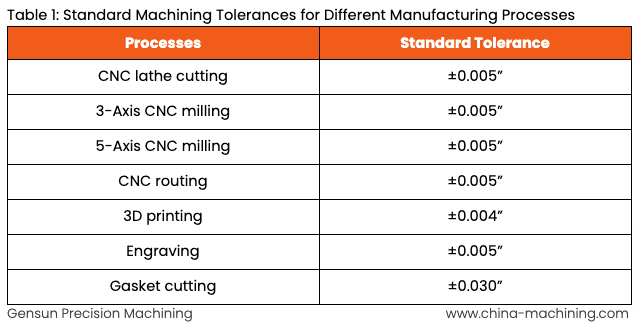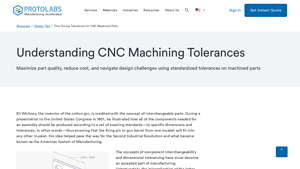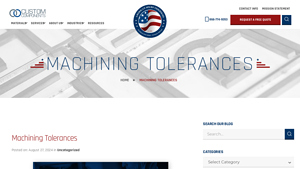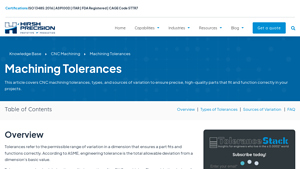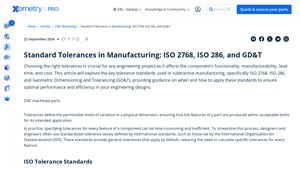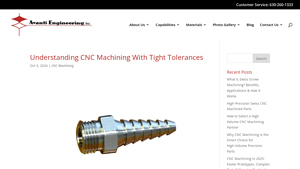Typical Machining Tolerances Guide: Type, Cost, Top List…
Introduction: Navigating the Global Market for typical machining tolerances
In the dynamic landscape of global manufacturing, understanding typical machining tolerances is crucial for B2B buyers looking to enhance product quality and operational efficiency. As international businesses strive to source precision-engineered components, the challenge of navigating varying standards and tolerances becomes increasingly complex. This guide delves into the intricacies of machining tolerances, providing a comprehensive overview of types, applications, and best practices for supplier vetting, cost considerations, and more.
Whether you are based in Nigeria, Brazil, or any part of Europe, the demand for consistency and reliability in manufacturing processes is universal. By equipping yourself with knowledge about machining tolerances, you can make informed purchasing decisions that align with your production requirements and budget constraints. This guide empowers you to understand how to measure and apply tolerances effectively, ensuring that the components you procure meet both functional and aesthetic standards.
With actionable insights and expert recommendations, this resource will help you navigate the complexities of sourcing machined parts on a global scale. By focusing on the critical parameters that govern tolerance levels, you can optimize your supply chain, reduce costs, and enhance the overall quality of your manufactured products. Join us as we explore the world of machining tolerances and unlock the potential for your business to thrive in an increasingly competitive marketplace.
Understanding typical machining tolerances Types and Variations
| Type Name | Key Distinguishing Features | Primary B2B Applications | Brief Pros & Cons for Buyers |
|---|---|---|---|
| Bilateral Tolerances | Allow deviation in both directions from the nominal size | General manufacturing, automotive parts | Pros: Flexibility in manufacturing; Cons: Potential for misalignment in assembly. |
| Unilateral Tolerances | Allow deviation in only one direction from the nominal size | Precision instruments, aerospace components | Pros: Greater control over dimensions; Cons: Limited flexibility may lead to higher costs. |
| Geometric Dimensioning and Tolerancing (GD&T) | Utilizes symbols to define features and tolerances | Complex assemblies, high-precision industries | Pros: Enhances communication; Cons: Requires specialized knowledge to interpret. |
| Maximum Material Condition (MMC) | Considers the maximum amount of material in a feature | Structural components, fittings | Pros: Optimizes material use; Cons: May complicate manufacturing processes. |
| Least Material Condition (LMC) | Focuses on the least amount of material in a feature | Lightweight structures, cost-sensitive applications | Pros: Reduces weight; Cons: Can affect strength and durability. |
What Are the Characteristics of Bilateral Tolerances and Their Suitability for B2B Buyers?
Bilateral tolerances allow for deviations in both directions from a specified nominal size, providing flexibility in manufacturing processes. This type of tolerance is commonly used in general manufacturing and automotive parts, where slight variations are acceptable. B2B buyers should consider this option when they require moderate precision without the constraints of stricter tolerances. However, while they offer flexibility, there is a risk of misalignment during assembly, which can lead to operational issues.
How Do Unilateral Tolerances Differ and When Should They Be Used?
Unilateral tolerances permit variation in only one direction, either above or below the nominal size. This is particularly important in applications requiring high precision, such as precision instruments and aerospace components. For B2B buyers, this type of tolerance ensures greater control over dimensions, which is crucial for maintaining quality. However, the lack of flexibility can lead to higher costs and potential complications during manufacturing if not managed carefully.
What Is Geometric Dimensioning and Tolerancing (GD&T) and Its Relevance in B2B Purchasing?
GD&T is a standardized system that uses specific symbols to define the allowable variations in the geometry of a part. It is particularly useful in complex assemblies and high-precision industries, where clear communication of tolerances is essential. For B2B buyers, adopting GD&T can facilitate better collaboration with manufacturers and reduce the risk of errors. However, it requires specialized knowledge to interpret correctly, which can be a barrier for some organizations.
Why Consider Maximum Material Condition (MMC) and Its Implications for Manufacturing?
Maximum Material Condition (MMC) refers to the scenario where a feature contains the maximum amount of material permissible. This is especially useful in structural components and fittings, where the fit is critical. B2B buyers can optimize material use and ensure the functionality of their products by specifying MMC. However, it may complicate manufacturing processes, requiring careful planning and execution to avoid production delays.
How Does Least Material Condition (LMC) Benefit Weight-Sensitive Applications?
Least Material Condition (LMC) focuses on minimizing the amount of material in a feature, which can be advantageous for lightweight structures and cost-sensitive applications. This approach allows B2B buyers to achieve significant weight reductions, enhancing the efficiency of their products. However, it is essential to consider that reducing material can affect the strength and durability of the components, which is a critical consideration for buyers in demanding industries.
Key Industrial Applications of typical machining tolerances
| Industry/Sector | Specific Application of typical machining tolerances | Value/Benefit for the Business | Key Sourcing Considerations for this Application |
|---|---|---|---|
| Automotive | Engine component manufacturing | Enhances performance and reliability of vehicles | Ensure suppliers can meet tight tolerances and provide certifications. |
| Aerospace | Aircraft part fabrication | Ensures safety and compliance with strict regulations | Focus on suppliers with experience in aerospace standards and materials. |
| Medical Devices | Surgical instrument production | Guarantees precision for critical operations | Verify that manufacturers comply with medical standards (ISO, FDA). |
| Oil & Gas | Drilling equipment and components | Improves efficiency and reduces downtime | Source from suppliers familiar with harsh environments and specific tolerances. |
| Electronics | PCB manufacturing | Ensures compatibility and functionality of components | Look for suppliers who can handle small tolerances and offer rapid prototyping. |
How are Typical Machining Tolerances Applied in the Automotive Industry?
In the automotive sector, typical machining tolerances are critical for manufacturing engine components like pistons and crankshafts. These parts must fit precisely to ensure optimal performance, reduce wear, and enhance fuel efficiency. For international buyers, especially from regions like Nigeria or Brazil, it is essential to partner with suppliers who can consistently meet tight tolerances and provide necessary certifications, ensuring that parts can be reliably integrated into larger systems without the need for additional machining.
What Role Do Machining Tolerances Play in Aerospace Manufacturing?
Aerospace manufacturing relies heavily on precise machining tolerances for components such as turbine blades and structural parts. The safety and performance of aircraft depend on the accuracy of these parts, which must adhere to stringent regulatory standards. Buyers from the Middle East and Europe should prioritize suppliers with a proven track record in aerospace applications, ensuring they understand the complexities of materials and tolerances specific to this industry.
Why are Tolerances Critical in Medical Device Production?
In the medical device sector, machining tolerances are paramount for producing surgical instruments and implants that require high precision. Any deviation can lead to serious consequences in patient outcomes. International buyers must ensure that their suppliers comply with relevant medical standards such as ISO and FDA regulations, which govern the manufacturing processes and quality control measures necessary for safe and effective medical devices.
How Do Typical Machining Tolerances Benefit the Oil & Gas Industry?
The oil and gas industry utilizes typical machining tolerances in the production of drilling equipment and components that operate in challenging environments. High precision is necessary to improve efficiency and minimize downtime. Buyers in this sector, particularly from regions with active oil exploration, should seek suppliers experienced in manufacturing for harsh conditions, ensuring they can deliver components that meet the specific tolerances required for safety and operational effectiveness.
In What Ways are Machining Tolerances Important for Electronics Manufacturing?
In electronics manufacturing, typical machining tolerances are essential for the production of printed circuit boards (PCBs) and other components. Accurate tolerances ensure that parts fit together correctly, maintaining functionality and compatibility. Buyers from South America and Africa should focus on sourcing from suppliers capable of handling small tolerances and offering rapid prototyping services, which are crucial for fast-paced electronics development cycles.
3 Common User Pain Points for ‘typical machining tolerances’ & Their Solutions
Scenario 1: Challenges with Overly Tight Tolerances Leading to Increased Costs
The Problem: B2B buyers often encounter the issue of specifying overly tight machining tolerances for their parts. This can arise from a lack of understanding of the manufacturing processes involved or the assumption that more precise tolerances will guarantee better quality. However, this approach can lead to significant increases in production costs due to the need for secondary operations like grinding or electrical discharge machining (EDM) to meet these stringent requirements. Additionally, it can extend lead times, disrupt supply chain efficiency, and ultimately affect the project timeline.
The Solution: To avoid the pitfalls of specifying overly tight tolerances, it is crucial to conduct a thorough analysis of the part’s functional requirements and the manufacturing capabilities of your supplier. Start by engaging in open discussions with your manufacturer about the intended application of the part. They can provide insights into the acceptable tolerances based on material selection and machining methods. Utilize standardized tolerances where possible, such as ±0.005 inches for prototype machining or ±0.002 inches for precision machining, as these are proven to balance cost and quality effectively. Implementing a collaborative design review can help align expectations and ensure that tolerances are set realistically, thereby optimizing both cost and quality.
Scenario 2: Difficulty in Achieving Consistency Across Multiple Parts
The Problem: In international supply chains, especially those involving suppliers from different regions like Africa, South America, or the Middle East, maintaining consistency in machining tolerances across multiple parts can be a significant challenge. Variability in manufacturing processes, equipment, and even environmental factors can lead to discrepancies in part dimensions. This inconsistency can result in assembly issues, increased rework, and ultimately, dissatisfied customers.
The Solution: To ensure consistency across parts from various suppliers, implement a robust quality assurance protocol that includes standardized testing and inspection methods. Specify the tolerances using the Geometric Dimensioning and Tolerancing (GD&T) system, which provides a clearer framework for understanding tolerances and their implications on part functionality. Establish a clear communication channel with suppliers to discuss quality expectations and conduct regular audits of their processes. Additionally, consider leveraging advanced technologies such as Coordinate Measuring Machines (CMM) for precise measurement and quality control. This proactive approach will help maintain consistency and reliability in your supply chain.
Scenario 3: Misalignment Between Design Specifications and Manufacturing Capabilities
The Problem: B2B buyers frequently face the issue of misalignment between design specifications and the manufacturing capabilities of their chosen suppliers. This misalignment often stems from a lack of understanding of what is feasible within the specified machining tolerances. As a result, parts may be produced that do not meet the desired specifications, leading to increased rejection rates, delays, and higher costs for re-engineering or re-manufacturing.
The Solution: To mitigate this issue, it is essential to involve your manufacturing partner early in the design process. Share your design specifications and engage in a dialogue about the tolerances that are achievable based on their equipment and processes. Use clear documentation, including detailed drawings and tolerance callouts, to communicate your requirements effectively. Consider conducting a Design for Manufacturability (DFM) analysis with your supplier to identify potential challenges early on. This collaborative effort will not only ensure that the tolerances specified are realistic and achievable but also foster a stronger partnership with your suppliers, ultimately leading to a smoother production process.
Strategic Material Selection Guide for typical machining tolerances
What Are the Key Properties of Aluminum in Machining Tolerances?
Aluminum is a lightweight metal known for its excellent machinability and corrosion resistance. It has a temperature rating of approximately 600°F (315°C) and can withstand moderate pressures, making it suitable for a variety of applications. Its low density and high strength-to-weight ratio are particularly beneficial in industries such as automotive and aerospace.
Pros & Cons of Aluminum for Machining Tolerances
Aluminum’s primary advantages include its ease of machining, which allows for tighter tolerances, and its resistance to corrosion, which extends the lifespan of components. However, it can be more expensive than some other metals, and its softness may lead to wear on cutting tools, increasing manufacturing complexity. Additionally, while aluminum is suitable for many applications, it may not be the best choice for high-stress environments.
Impact on Applications
Aluminum is compatible with various media, including water and some chemicals, making it versatile for different applications. However, it is essential to consider its limitations in high-temperature or high-pressure environments, as these can affect its performance.
How Does Steel Compare in Terms of Machining Tolerances?
Steel is a widely used material in machining due to its durability and strength. With a temperature rating that can exceed 1,500°F (815°C) and high pressure ratings, steel is suitable for heavy-duty applications. It also offers excellent wear resistance, making it ideal for parts subjected to friction.
Pros & Cons of Steel for Machining Tolerances
The key advantage of steel is its strength and durability, allowing for tighter tolerances and longer-lasting parts. However, steel can be more challenging to machine compared to aluminum, leading to higher manufacturing costs and complexity. Additionally, it is prone to corrosion unless treated, which can limit its applications in certain environments.
Impact on Applications
Steel’s compatibility with various media, including oils and fuels, makes it a common choice for automotive and industrial applications. However, international buyers must consider corrosion resistance and compliance with standards such as ASTM or DIN, particularly in regions with high humidity or saline environments.
What Are the Advantages of Using Plastic in Machining Tolerances?
Plastics, such as polycarbonate and nylon, are increasingly popular in machining due to their lightweight and corrosion-resistant properties. They can typically withstand temperatures up to 200°F (93°C) and moderate pressures, making them suitable for various applications.
Pros & Cons of Plastics for Machining Tolerances
The primary advantage of plastics is their low cost and ease of machining, allowing for complex shapes and tighter tolerances. However, they may not offer the same level of durability as metals, which can limit their use in high-stress applications. Additionally, certain plastics may degrade under UV light or extreme temperatures.
Impact on Applications
Plastics are often used in consumer goods and electrical components due to their versatility and resistance to chemicals. International buyers should ensure compliance with relevant standards, especially in industries like food and pharmaceuticals, where material safety is critical.
How Do Composites Perform in Machining Tolerances?
Composite materials, such as carbon fiber reinforced polymers, are gaining traction in industries requiring high strength-to-weight ratios. They can withstand temperatures up to 300°F (149°C) and offer excellent corrosion resistance.
Pros & Cons of Composites for Machining Tolerances
The key advantage of composites is their superior strength and lightweight nature, allowing for tight machining tolerances. However, they can be more expensive and complex to manufacture, requiring specialized equipment. Additionally, they may not be suitable for all applications due to their brittleness.
Impact on Applications
Composites are ideal for aerospace and automotive applications where weight savings are critical. International buyers should consider compliance with industry-specific standards and the availability of qualified manufacturers.
Summary Table of Material Selection for Machining Tolerances
| Material | Typical Use Case for typical machining tolerances | Key Advantage | Key Disadvantage/Limitation | Relative Cost (Low/Med/High) |
|---|---|---|---|---|
| Aluminum | Aerospace components, automotive parts | Lightweight and corrosion-resistant | Softness can lead to tool wear | Medium |
| Steel | Heavy machinery, automotive parts | High strength and durability | More challenging to machine | Medium to High |
| Plastic | Consumer goods, electrical components | Low cost and easy to machine | Limited durability in high-stress applications | Low |
| Composites | Aerospace, automotive lightweight structures | Superior strength-to-weight ratio | Higher cost and complexity | High |
In-depth Look: Manufacturing Processes and Quality Assurance for typical machining tolerances
What Are the Main Stages of Manufacturing Processes for Typical Machining Tolerances?
In the realm of manufacturing, especially for precision machining, understanding the various stages and techniques involved is crucial for ensuring quality and adherence to specified tolerances. The typical manufacturing process encompasses several key stages: material preparation, forming, assembly, and finishing. Each stage is vital in ensuring that the final product meets the required specifications.
How is Material Prepared for Machining Tolerances?
Material preparation is the foundational step in the machining process. It involves selecting the right type of material based on the application’s requirements, which may include mechanical properties, thermal stability, and corrosion resistance. Common materials include metals such as aluminum, steel, and titanium, as well as plastics and composites.
Once the material is selected, it is cut to size using techniques such as sawing or shearing. This initial shaping is crucial, as any inaccuracies at this stage can compound in later processes. After cutting, the material often undergoes additional treatments like annealing or hardening to enhance its properties and prepare it for machining.
What Techniques Are Used in the Forming Stage?
The forming stage involves transforming the prepared material into a shape that aligns with design specifications. Techniques such as CNC machining, turning, milling, and electrical discharge machining (EDM) are commonly employed.
CNC machining is particularly favored for its precision and ability to produce complex geometries while maintaining tight tolerances. During this stage, operators must monitor parameters such as feed rate, spindle speed, and tool selection to ensure that the machining process achieves the desired accuracy.
How Is Assembly Managed in Machining Processes?
In many manufacturing scenarios, particularly in the production of assemblies, the assembly stage is critical. This involves the integration of various machined components into a final product. The accuracy of individual parts directly affects the overall assembly quality.
Proper alignment and fitting during assembly are essential to maintain tolerances. Techniques like jig and fixture design can help ensure that parts are held in the correct position during assembly, reducing the risk of misalignment.
What Is Involved in the Finishing Stage?
The finishing stage is where the final touches are applied to the product. This may include processes such as grinding, polishing, or coating. These techniques not only enhance the aesthetic appeal of the product but also play a significant role in achieving the required surface finish, which can influence the part’s performance in its intended application.
Quality assurance during the finishing stage is paramount, as even minor deviations can lead to functional failures. Hence, adherence to specified tolerances must be rigorously checked before the product moves to the next phase.
How Is Quality Control Implemented in Machining Processes?
Quality control (QC) is an integral part of the manufacturing process, particularly for industries that demand high precision and reliability. International standards such as ISO 9001 set the framework for effective quality management systems, ensuring that organizations maintain consistent quality across their products.
What Are the Key International Standards for Quality Control?
ISO 9001 is a widely recognized standard that outlines the criteria for a quality management system. Adopting this standard helps organizations streamline processes, reduce waste, and improve customer satisfaction. Additionally, industry-specific standards such as CE marking for safety and API standards for oil and gas components further enhance product credibility in international markets.
What Are the Critical QC Checkpoints Throughout the Manufacturing Process?
Quality control checkpoints are strategically placed throughout the manufacturing process to ensure that products meet the specified tolerances. The main checkpoints include:
- Incoming Quality Control (IQC): This initial inspection assesses the quality of raw materials before they enter the production process.
- In-Process Quality Control (IPQC): Conducted during various manufacturing stages, IPQC ensures that each process step adheres to quality standards.
- Final Quality Control (FQC): This final inspection evaluates the completed product to verify that it meets all design specifications and quality standards before shipping.
What Common Testing Methods Are Used for Machined Parts?
Various testing methods are employed to validate the quality of machined parts. Common techniques include:
- Dimensional Inspection: Utilizing tools like calipers and micrometers to measure critical dimensions against specified tolerances.
- Functional Testing: Ensuring that the part performs as intended in its application.
- Non-Destructive Testing (NDT): Techniques such as ultrasonic testing or X-ray inspection help identify internal flaws without damaging the part.
How Can B2B Buyers Verify Supplier Quality Control?
For international B2B buyers, particularly in regions like Africa, South America, the Middle East, and Europe, verifying supplier quality control is crucial to ensure reliable partnerships. Here are several strategies:
What Are the Best Practices for Conducting Supplier Audits?
Conducting supplier audits is one of the most effective ways to assess a manufacturer’s quality control processes. During these audits, buyers can evaluate the supplier’s adherence to international standards, review documentation, and observe production practices firsthand.
How Can Buyers Use Quality Control Reports?
Requesting quality control reports from suppliers can provide insights into their QC processes and results. These reports often include data on inspection results, defect rates, and corrective actions taken, allowing buyers to gauge the supplier’s commitment to quality.
What Role Do Third-Party Inspections Play in Quality Assurance?
Engaging third-party inspection services offers an unbiased assessment of a supplier’s quality control practices. These independent entities can conduct thorough inspections and testing, providing an additional layer of assurance for buyers.
What Are the Quality Control Nuances for International B2B Transactions?
When dealing with international suppliers, particularly in diverse markets, B2B buyers must be aware of specific quality control nuances. Differences in manufacturing standards, regulatory requirements, and cultural practices can affect quality expectations.
Buyers should familiarize themselves with the local standards and practices in the supplier’s country while also ensuring that the suppliers are capable of meeting international quality benchmarks. Establishing clear communication regarding quality expectations and tolerances upfront can help mitigate misunderstandings and ensure a successful partnership.
Conclusion
Navigating the complexities of manufacturing processes and quality assurance for machining tolerances is essential for B2B buyers seeking reliable suppliers. By understanding the stages of manufacturing, implementing rigorous quality control measures, and verifying supplier capabilities, buyers can ensure that they receive products that meet their high standards of precision and reliability.
Practical Sourcing Guide: A Step-by-Step Checklist for ‘typical machining tolerances’
Introduction
This sourcing guide aims to provide international B2B buyers with a clear, actionable checklist for procuring typical machining tolerances. Understanding and implementing the right tolerances is crucial for ensuring product quality, minimizing costs, and achieving seamless assembly in your manufacturing processes. This guide will help you navigate the complexities of machining tolerances to make informed sourcing decisions.
Step 1: Define Your Technical Specifications
Establishing precise technical specifications is the foundation of successful machining procurement. Clearly outline the dimensions, tolerances, and material requirements for your parts. This will help suppliers understand your needs and provide accurate quotes, reducing the risk of miscommunication.
- Consider standard tolerances: Familiarize yourself with industry-standard tolerances, such as ±0.005 in. for typical parts, to set realistic expectations.
- Incorporate flexibility: Identify areas where tolerances can be adjusted without compromising part functionality, which may reduce costs.
Step 2: Research and Select Suppliers
Thoroughly researching potential suppliers is essential to ensure quality and reliability. Look for manufacturers with a solid track record in machining and a specialization in the materials you require.
- Check certifications: Verify that suppliers hold relevant certifications, such as ISO 9001, which demonstrates adherence to quality management standards.
- Review capabilities: Assess their capabilities to meet your specified tolerances and understand their machining processes, such as CNC machining.
Step 3: Request Detailed Quotes
Once you have shortlisted suppliers, request detailed quotes that include pricing, lead times, and specific tolerances. A comprehensive quote will enable you to compare suppliers effectively.
- Clarify tolerances: Ensure that the quoted tolerances align with your technical specifications, as discrepancies can lead to costly adjustments later.
- Understand pricing factors: Ask how tolerances affect pricing to identify any cost-saving opportunities without sacrificing quality.
Step 4: Evaluate Manufacturing Processes
Understanding the manufacturing processes used by your suppliers is critical for ensuring they can meet your tolerance requirements. Different processes can yield varying levels of precision.
- Inquire about technology: Ask about the machining technologies they employ, such as CNC machining, which can provide tighter tolerances.
- Assess production capacity: Ensure the supplier has the capacity to handle your order volume while maintaining quality standards.
Step 5: Conduct Quality Assurance Checks
Before finalizing your order, establish a plan for quality assurance. This step is vital for maintaining the integrity of your parts throughout production.
- Request samples: If possible, obtain samples to verify that the supplier can meet your specified tolerances.
- Implement inspections: Develop a quality inspection plan that includes in-process checks and final inspections to catch any deviations early.
Step 6: Establish Clear Communication Channels
Effective communication is essential for a successful partnership with your suppliers. Set up channels for ongoing dialogue regarding specifications, timelines, and any potential issues.
- Designate a point of contact: Assign a dedicated representative to manage communications and ensure that all parties are aligned.
- Utilize technology: Consider using project management tools to facilitate real-time updates and collaboration throughout the production process.
Step 7: Review and Assess Post-Delivery
Once you receive your parts, conduct a thorough review to assess whether they meet your specifications and tolerances. This final step is crucial for long-term supplier relationships.
- Document findings: Keep a record of any discrepancies and communicate them to your supplier for resolution.
- Provide feedback: Share constructive feedback with your supplier to improve future transactions and foster a collaborative relationship.
Comprehensive Cost and Pricing Analysis for typical machining tolerances Sourcing
What are the Key Cost Components in Machining Tolerances Sourcing?
When sourcing machining tolerances, understanding the cost structure is essential for B2B buyers. The primary cost components include:
-
Materials: The type of material significantly impacts costs. Metals such as aluminum and steel are commonly used, with prices fluctuating based on market conditions. Specialty materials may incur higher costs due to limited availability or specific processing requirements.
-
Labor: Skilled labor is crucial for achieving precise machining tolerances. Labor costs can vary widely depending on the region, with developed countries generally having higher wage standards compared to developing regions. Additionally, labor costs may be affected by the complexity of the machining process and the level of expertise required.
-
Manufacturing Overhead: This includes utilities, equipment maintenance, and facility costs. High overhead can stem from using advanced machinery or maintaining strict quality control standards, which are essential for precision machining.
-
Tooling: Tooling costs encompass the expenses associated with creating or maintaining cutting tools, jigs, and fixtures. Custom tooling can be a significant investment, particularly for specialized components requiring tight tolerances.
-
Quality Control (QC): Ensuring that parts meet specified tolerances often involves rigorous testing and inspection processes. QC costs can include the use of specialized equipment and trained personnel, which are essential for maintaining high standards.
-
Logistics: Transportation and storage costs can add to the overall expense, particularly for international shipments. Factors such as shipping distance, weight, and handling requirements can influence logistics costs significantly.
-
Margin: Suppliers typically include a profit margin in their pricing, which can vary based on competition, market conditions, and the perceived value of the service provided.
What Influences Pricing for Machining Tolerances?
Several factors can influence the pricing of machining tolerances:
-
Volume/MOQ: Higher order volumes often lead to lower per-unit costs due to economies of scale. Buyers should negotiate minimum order quantities (MOQ) to optimize pricing.
-
Specifications and Customization: Custom parts with unique specifications may command higher prices due to the increased complexity and labor involved in their production.
-
Material Selection: The choice of material not only affects the initial cost but also impacts machining processes. Some materials require specialized tools and longer machining times, which can elevate costs.
-
Quality Certifications: Parts that require specific quality certifications (e.g., ISO, AS9100) may incur additional costs associated with compliance and testing.
-
Supplier Factors: The reputation and reliability of suppliers can influence pricing. Established suppliers with proven track records may charge a premium for their services.
-
Incoterms: Understanding shipping terms is crucial for calculating total costs. Different Incoterms dictate who bears the responsibility for shipping, insurance, and tariffs, affecting the final price.
What Tips Can Help Buyers Optimize Costs in Machining Tolerances?
To maximize cost-efficiency in sourcing machining tolerances, consider these tips:
-
Negotiate Effectively: Engage in open discussions with suppliers about pricing and payment terms. Leverage your purchasing power, especially if you’re a repeat customer or planning to place a large order.
-
Evaluate Total Cost of Ownership (TCO): Look beyond the initial price and consider long-term costs, including maintenance, potential rework, and the impact of tolerances on product performance.
-
Understand Pricing Nuances for International Sourcing: Be aware of currency fluctuations, import/export duties, and regional market conditions. These factors can significantly impact the final cost of sourced parts.
-
Streamline Specifications: Where possible, standardize designs and tolerances to reduce complexity. This can lead to lower costs and improved manufacturability.
Disclaimer on Indicative Prices
Prices for machining tolerances can fluctuate based on various factors, including market conditions, material availability, and specific project requirements. It is advisable for buyers to obtain detailed quotes from multiple suppliers to ensure competitive pricing tailored to their unique needs.
Alternatives Analysis: Comparing typical machining tolerances With Other Solutions
Exploring Alternatives to Typical Machining Tolerances in Manufacturing
In the realm of manufacturing, achieving precise dimensions is essential for product quality and functionality. However, typical machining tolerances, while effective, are not the only means to achieve desired outcomes. This section explores viable alternatives that may offer unique benefits depending on the specific needs of B2B buyers across various regions, including Africa, South America, the Middle East, and Europe.
Comparison Table
| Comparison Aspect | Typical Machining Tolerances | Additive Manufacturing | Injection Molding |
|---|---|---|---|
| Performance | High precision (±0.005 in.) | Variable, high detail | High volume, consistent |
| Cost | Moderate to high | High for low volumes | Economical for large runs |
| Ease of Implementation | Requires skilled labor | Requires specialized tech | Established process |
| Maintenance | Moderate | Low | Low |
| Best Use Case | Custom parts, low volume | Complex geometries, prototypes | Mass production, uniformity |
What Are the Pros and Cons of Additive Manufacturing?
Additive manufacturing, commonly known as 3D printing, provides a flexible approach to creating complex geometries that are often difficult or impossible to achieve with traditional machining. One of its primary advantages is the ability to produce intricate designs without the need for tooling, making it ideal for prototyping and low-volume production. However, the performance of additive manufacturing can vary based on the material used and the specific printing technology, which may not always meet the stringent tolerances required for certain applications. Additionally, while initial costs can be high, they often become more economical for smaller production runs.
How Does Injection Molding Compare to Typical Machining Tolerances?
Injection molding is a highly efficient manufacturing process, particularly suited for high-volume production. It allows for the consistent production of parts with tight tolerances and excellent surface finishes. This method is cost-effective when producing large quantities, as the cost per unit decreases significantly with scale. However, the initial investment in molds and setup can be considerable, making it less viable for low-volume needs. Furthermore, design changes can be costly and time-consuming, as new molds must often be created.
Conclusion: Which Solution is Right for Your B2B Needs?
When choosing between typical machining tolerances and alternative manufacturing solutions, B2B buyers must consider their specific project requirements, including volume, complexity, and budget. For projects requiring high precision and lower volumes, typical machining tolerances might be the best fit. In contrast, additive manufacturing offers flexibility for complex designs and rapid prototyping, while injection molding excels in high-volume production scenarios. By understanding the strengths and limitations of each approach, buyers can make informed decisions that align with their operational goals and market demands.
Essential Technical Properties and Trade Terminology for typical machining tolerances
What Are the Key Technical Properties of Typical Machining Tolerances?
When engaging with international suppliers and manufacturers, understanding essential technical properties related to machining tolerances is critical for ensuring product quality and cost-effectiveness. Here are some key specifications to consider:
1. Tolerance Levels
Machining tolerance is a key specification that defines the allowable variation from a specified dimension. For example, a tolerance of ±0.005 inches means the actual dimension can deviate by five thousandths of an inch from the nominal size. In B2B contexts, tighter tolerances often lead to higher costs, so understanding the balance between quality and expense is essential for procurement strategies.
2. Material Grade
The material grade of the components being machined significantly influences the tolerances that can be achieved. Different materials, such as aluminum, steel, or plastics, have varying characteristics that affect how they respond to machining processes. Buyers must specify material grades accurately to ensure that the finished products meet the required performance standards and tolerances.
3. Surface Finish
Surface finish refers to the texture of a machined part’s surface, which can impact both functionality and aesthetics. It is typically measured in terms of Ra (roughness average) values. A smoother finish often requires tighter tolerances and more advanced machining techniques, which can increase production costs. Understanding the required surface finish is vital for B2B buyers to avoid costly rework or quality issues.
4. Geometric Dimensioning and Tolerancing (GD&T)
GD&T is a standardized system for defining and communicating engineering tolerances. It helps in specifying the allowable variations in size, form, orientation, and location of part features. Familiarity with GD&T is crucial for international buyers, as it ensures that all parties involved in the manufacturing process have a common understanding of the tolerances required, minimizing miscommunication and errors.
5. Maximum Material Condition (MMC) and Least Material Condition (LMC)
MMC and LMC are critical concepts in machining tolerances that define the conditions under which parts must fit together. MMC refers to the state where a feature contains the maximum amount of material, while LMC refers to the minimum. These conditions are essential for ensuring proper fit and function in assemblies, making it important for buyers to understand how these concepts impact their product designs.
What Are Common Trade Terms Related to Machining Tolerances?
Understanding industry jargon can facilitate smoother communication and negotiation with suppliers. Here are some common terms that B2B buyers should be familiar with:
1. Original Equipment Manufacturer (OEM)
An OEM refers to a company that produces parts or equipment that may be marketed by another manufacturer. OEMs are crucial in the machining industry as they often dictate the specifications and tolerances required for their products, impacting purchasing decisions.
2. Minimum Order Quantity (MOQ)
MOQ is the smallest quantity of a product that a supplier is willing to sell. Understanding MOQs is essential for B2B buyers, especially when managing inventory costs or when dealing with new suppliers. Buyers should negotiate MOQs that align with their production needs to avoid excess inventory.
3. Request for Quotation (RFQ)
An RFQ is a document that a buyer sends to potential suppliers to solicit price quotes for specific products or services. Including detailed specifications, such as machining tolerances and material grades in an RFQ can lead to more accurate and competitive quotes.
4. Incoterms
Incoterms are internationally recognized commercial terms that define the responsibilities of buyers and sellers in a transaction. Familiarity with Incoterms is crucial for B2B buyers to understand shipping costs, risk, and liability, particularly in international trade.
5. Lead Time
Lead time refers to the amount of time it takes from placing an order until the product is delivered. Understanding lead times is essential for effective supply chain management and production planning, particularly in industries where timing is critical.
By grasping these technical properties and trade terms, B2B buyers can make informed decisions, negotiate effectively, and ensure that their machining projects meet quality standards and budget constraints.
Navigating Market Dynamics and Sourcing Trends in the typical machining tolerances Sector
Market Overview & Key Trends in Typical Machining Tolerances
The global market for machining tolerances is increasingly driven by advancements in manufacturing technology, particularly in CNC machining and additive manufacturing. As industries across Africa, South America, the Middle East, and Europe continue to modernize, the demand for precision-engineered components is rising. Buyers are particularly focused on achieving tighter tolerances to ensure product quality and compatibility, leading to a greater emphasis on standardized machining processes.
Emerging B2B trends include the adoption of Industry 4.0 technologies, such as the Internet of Things (IoT) and artificial intelligence, which enhance operational efficiency and quality control. These technologies enable real-time monitoring of machining processes, allowing manufacturers to maintain stringent tolerances while reducing waste and operational costs. Additionally, the growing trend towards customization in manufacturing is prompting suppliers to offer flexible machining solutions that cater to specific buyer needs, particularly in sectors like automotive and aerospace.
International buyers are also navigating complex market dynamics, including fluctuating material costs and global supply chain disruptions. In regions like Nigeria and Brazil, local manufacturers are increasingly seeking partnerships with international suppliers to leverage advanced machining capabilities. This strategic collaboration allows for improved access to high-precision components while mitigating risks associated with sourcing from multiple vendors.
How Does Sustainability & Ethical Sourcing Impact the Machining Tolerances Sector?
Sustainability is becoming a critical consideration in the machining tolerances sector, as environmental impact and ethical sourcing take precedence for B2B buyers. The machining industry is under pressure to reduce its carbon footprint by adopting greener manufacturing practices and utilizing sustainable materials. This shift is particularly relevant in regions where environmental regulations are tightening, compelling manufacturers to invest in eco-friendly technologies.
Ethical supply chains are equally important, with buyers increasingly prioritizing suppliers that demonstrate a commitment to responsible sourcing practices. This includes ensuring that raw materials are procured from certified sources and that labor practices adhere to ethical standards. Certifications such as ISO 14001 for environmental management and ISO 9001 for quality management are becoming essential in vendor selection processes.
Moreover, the utilization of ‘green’ materials, such as recycled metals and biodegradable composites, is gaining traction. These materials not only reduce environmental impact but also appeal to a growing consumer base that values sustainability. By aligning sourcing strategies with sustainability goals, B2B buyers can enhance their brand reputation and attract eco-conscious clients.
What is the Brief Evolution of Machining Tolerances in B2B Manufacturing?
The concept of machining tolerances has evolved significantly since the early days of manufacturing. Initially rooted in the need for interchangeable parts, as exemplified by Eli Whitney’s work in the 1800s, the focus on precision has only intensified with the advent of advanced technologies.
Throughout the 20th century, the rise of CNC machining revolutionized the industry, allowing for tighter tolerances and higher accuracy in production. The introduction of standardized tolerancing systems, such as Geometric Dimensioning and Tolerancing (GD&T), provided a framework for manufacturers to communicate precise specifications effectively.
Today, the ongoing integration of digital technologies and automation is pushing the boundaries of what is possible in machining tolerances. As industries demand greater efficiency and quality, the evolution of this sector continues to reshape how businesses approach manufacturing and sourcing, ultimately fostering a landscape where precision and sustainability coexist.
Frequently Asked Questions (FAQs) for B2B Buyers of typical machining tolerances
-
How do I choose the right machining tolerance for my project?
Choosing the right machining tolerance depends on the specific requirements of your project, including the function of the part, the materials used, and the manufacturing processes involved. Start by assessing the critical features of your component and determine how tight the tolerances need to be to ensure proper fit and function. It’s advisable to consult with your supplier, as they can provide insights based on their capabilities and industry standards. Keep in mind that tighter tolerances can increase costs and lead times, so balance precision with practicality. -
What is the standard machining tolerance for CNC parts?
The standard machining tolerance for CNC parts typically ranges from ±0.005 inches (±0.13 mm) for general production to ±0.002 inches (±0.051 mm) for precision applications. Depending on the complexity of the part and the material used, some manufacturers can achieve even tighter tolerances, such as ±0.0005 inches (±0.0127 mm). When requesting quotes, specify your tolerance requirements to ensure that the manufacturer can meet your expectations without incurring unnecessary costs. -
How do I verify the machining tolerances provided by my supplier?
To verify machining tolerances, request detailed documentation from your supplier, including inspection reports and certifications that demonstrate their adherence to specified tolerances. Utilize third-party inspection services if necessary, especially for critical components. Additionally, consider implementing a quality assurance process that includes random checks of received parts against your specified tolerances to ensure ongoing compliance and quality. -
What factors influence the cost of machining tolerances?
The cost of machining tolerances is influenced by several factors, including the complexity of the part design, the required precision, the material used, and the manufacturing method. Tighter tolerances often require more advanced machinery and longer processing times, which can increase costs. Additionally, the volume of parts ordered (MOQ) can impact pricing; larger orders typically benefit from economies of scale. Discuss these factors with your supplier to understand how they affect your overall budget. -
How can I ensure timely delivery of machined parts with specific tolerances?
To ensure timely delivery, communicate your project timelines clearly with your supplier from the outset. Provide them with accurate specifications, including tolerances, and confirm their capacity to meet your deadlines. Establishing a strong relationship with your supplier can also facilitate smoother communication and quicker problem resolution. Consider setting up regular progress updates or milestones to monitor the production process and address any potential delays promptly. -
What are the common payment terms for international machining projects?
Payment terms for international machining projects can vary widely based on the supplier’s policies and the nature of the transaction. Common terms include upfront deposits, payment upon delivery, or net 30/60 days post-delivery. It’s essential to discuss and agree on payment terms before commencing production to avoid misunderstandings. Additionally, consider using secure payment methods and escrow services for larger transactions to protect both parties. -
How do I vet suppliers for machining tolerances internationally?
Vetting suppliers involves researching their reputation, capabilities, and quality standards. Start by reviewing their certifications (such as ISO 9001) and customer testimonials. Request samples of their work to assess quality and adherence to tolerances. Furthermore, consider visiting the supplier’s facility if feasible, or conducting a virtual audit to evaluate their processes. Engaging with industry associations or trade groups can also provide valuable insights into reliable suppliers in your target regions. -
What customization options should I consider when sourcing machined parts?
When sourcing machined parts, consider customization options such as material selection, surface finish, and specific tolerances based on your application needs. Discuss your design requirements with the supplier to explore potential modifications that can enhance performance or reduce costs. Additionally, inquire about their capabilities for prototyping or small batch runs, which can help you test and refine your designs before committing to larger production volumes.
Important Disclaimer & Terms of Use
⚠️ Important Disclaimer
The information provided in this guide, including content regarding manufacturers, technical specifications, and market analysis, is for informational and educational purposes only. It does not constitute professional procurement advice, financial advice, or legal advice.
While we have made every effort to ensure the accuracy and timeliness of the information, we are not responsible for any errors, omissions, or outdated information. Market conditions, company details, and technical standards are subject to change.
B2B buyers must conduct their own independent and thorough due diligence before making any purchasing decisions. This includes contacting suppliers directly, verifying certifications, requesting samples, and seeking professional consultation. The risk of relying on any information in this guide is borne solely by the reader.
Top 8 Typical Machining Tolerances Manufacturers & Suppliers List
1. Protolabs – Precision Machining Tolerances
Domain: protolabs.com
Registered: 2006 (19 years)
Introduction: Standard prototype and production machining tolerance: +/- 0.005 in. (0.13mm); Standard precision machining tolerance: +/- 0.002 in. (0.051 mm); Tolerance on reamed holes: +/- 0.0005 in. (0.0127mm); Tolerance on feature locations: +/- 0.002 in. (0.051mm) on the same side of the part; Ability to achieve greater accuracy based on part geometry and material; Tolerances can be expressed in bilateral, …
2. Reddit – 6061 Aluminum Precision Part
Domain: reddit.com
Registered: 2005 (20 years)
Introduction: Part material: 6061 aluminum; Part dimensions: 60mm x 20mm x 5mm; Standard tolerance: ±0.005″; Primary machining tool: 1/8″ endmill; Tolerance considerations: cost increases with tighter tolerances.
3. American Micro – Machining Tolerances
Domain: americanmicroinc.com
Registered: 2001 (24 years)
Introduction: Machining Tolerances define the total amount of dimensional variation allowed from a specified value, ensuring components function properly within assemblies. Key aspects include: 1. Tolerance specifications: Upper and lower limits, allowable deviation notation, standalone variance values. 2. Tolerance bands: Tight bands require precise manufacturing; loose bands allow economical production. 3. CN…
4. HPPI – CNC Machining Tolerances Guide
Domain: hppi.com
Registered: 1997 (28 years)
Introduction: Technical Guide on CNC Machining Tolerances covering types of tolerances, sources of variation, and their importance in ensuring precise, high-quality parts. Key points include: 1. Overview of tolerances as permissible variation ranges in dimensions. 2. Types of CNC machining tolerances: Standard, Limit, Unilateral, and Bilateral. 3. Sources of variation: Raw material, workpiece condition, CNC mac…
5. Xometry – Standard Tolerances
Domain: xometry.pro
Registered: 2023 (2 years)
Introduction: Standard Tolerances in Manufacturing: ISO 2768 & ISO 286. Key tolerance standards include ISO 2768 for general tolerances on linear and angular dimensions, and ISO 286 for cylindrical surfaces and parallel plane surfaces. Xometry offers standardized tolerance options: ISO 2768 – Fine, ISO 2768 – Medium, ISO 286 – Grade 6, ISO 286 – Grade 7, ISO 286 – Grade 8. Selecting the right tolerance is cruci…
6. IMC Intertech – Precision Micromachining Solutions
Domain: imcintertech.com
Registered: 2003 (22 years)
Introduction: Tightest micromachining tolerances as small as 1 micron (0.00004 in). Standard machining tolerances from ± 0.005″ down to ± 0.002″ (± 0.127 mm down to ± 0.050 mm). Smallest micro machining tolerances from ± 0.002″ down to ± 0.0004″ (± 0.050 mm down to ± 0.010 mm). Smallest micro EDM tolerances from ± 0.001″ down to ± 0.0004″ (± 0.025 mm down to ± 0.010 mm). Smallest femtosecond laser machining tol…
7. Cheetah Precision – Precision Machining Services
Domain: cheetahprecision.com
Registered: 1999 (26 years)
Introduction: Cheetah Precision specializes in precision machining with a common tolerance benchmark of ± 0.005″ (0.127 mm) for CNC machining, and capabilities to achieve tighter tolerances up to ± 0.0001″. They offer various machining services including CNC milling and turning for both small and large quantities, as well as prototype parts. The company emphasizes the importance of working closely with customer…
8. Avanti Engineering – Precision CNC Machining
Domain: avantiengineering.com
Registered: 2000 (25 years)
Introduction: Avanti Engineering specializes in CNC machining with tight tolerances, typically around ±0.001 inches. They are ISO 9001:2015 certified and implement a C=0 sampling plan for quality assurance. Their services include CNC machining, CNC turning & milling, custom machining, high-volume machining, multi spindle screw machining, and Swiss CNC machining. They work with various materials such as steel, a…
Strategic Sourcing Conclusion and Outlook for typical machining tolerances
In conclusion, understanding typical machining tolerances is paramount for international B2B buyers seeking to enhance product quality and operational efficiency. By prioritizing appropriate tolerances in your sourcing strategy, you can ensure that components fit together seamlessly, reducing the risk of costly reworks and delays. Standardized tolerances, such as ±0.005 inches for prototypes, provide a solid foundation for assessing quality while offering flexibility for precision needs.
Strategic sourcing not only involves selecting suppliers based on cost but also on their capability to meet stringent tolerance requirements. As markets in Africa, South America, the Middle East, and Europe continue to evolve, aligning your sourcing decisions with manufacturers who understand local and international standards can provide a competitive edge.
Looking ahead, it is essential to stay informed about advancements in machining technologies and tolerance specifications. Engage with suppliers who demonstrate innovation and reliability in their processes. As you refine your sourcing strategies, consider how tailored machining tolerances can contribute to your long-term success. Embrace this opportunity to enhance your supply chain resilience and quality assurance practices, ensuring your products meet the demands of global markets.
